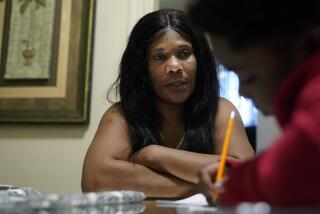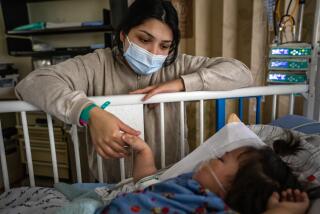Alert Teacher Spots Bad Blood
- Share via
The bruises on her son’s body seemed to Tori Hensley nothing more than the marks of a rambunctious 5-year-old who often roughhouses with friends and takes frequent spills from his bike.
But for Ryan Hensley’s kindergarten teacher, the black-and-blue splotches on the boy’s arms, legs and back touched off alarm bells signaling a potential medical emergency.
“My mind told me something wasn’t right,” said Lynda Wicks, a veteran kindergarten teacher at Alderwood Basics Plus Elementary School in Irvine. “I was worried about some kind of blood disease, maybe leukemia, something wrong with his blood. I had the gut feeling something wasn’t right.”
In a matter of 24 hours, Wicks’ insistence on having a school nurse examine Ryan led to a doctor’s visit, lab tests and an overnight stay at Children’s Hospital of Orange County.
Wicks’ mental warning lights set in motion a chain of events that identified a treatable blood disorder in the little boy.
Wicks first noticed Ryan’s bruises when he rested his elbow on a table during a reading group the morning of April 5. Having witnessed three decades’ worth of students’ scrapes, cuts and bruises, she asked the boy if he was learning to ride a bike.
His answer was unusual.
“ ‘I bruise easy,’ ” she recalled him saying. “ ‘See, I have them here too,’ and he showed me his other arm.”
Suddenly alert, Wicks asked to see the bruises--a dappling on his legs, a purple smudge on his back. The boy chalked up the back bruise to lying on the floor.
Wicks called for a nurse, who came first thing the next morning.
When school nurse Claudine Yamaoka examined Ryan the next day, she said, she zeroed in on the small red spots on the skin on the inside of his elbow, known as petechiae, which are telltale signs of a blood disorder.
Yamaoka got on the phone to Tori Hensley at work and said Ryan should see a pediatrician right away for blood tests.
Ryan visited his pediatrician that afternoon and had some blood drawn. The results came back four hours later while the Hensley family was cleaning up the dishes after dinner.
The doctor told Hensley to head immediately to CHOC, where a hematologist and a hospital bed were waiting for Ryan.
The diagnosis was a blood disorder the kindergartner can’t pronounce: idiopathic thrombocytopenic purpura, or ITP.
The disorder, which is estimated to affect one in 10,000 children, results in a severe shortage of platelets, the cells responsible for the blood’s ability to clot. This causes bruises in places where no trauma has occurred as well as tiny red spots on the skin, said Dr. Guy Young, a pediatric hematologist at CHOC who treated Ryan. In severe cases, prolonged nosebleeds and bleeding gums can also be symptoms. Ryan had a less severe case.
Intravenous treatment brought Ryan’s platelet level to normal, and he soon was released from the hospital.
The body usually corrects ITP on its own in six months to a year, even without treatment, Young said. Within a week of Ryan’s treatment his bruises were gone, and he will be making follow-up visits with doctors in the coming weeks.
Educators also saw the case as underscoring the importance of observant teachers and trained nurses on school campuses.
“So much of what professional school nurses do is invisible work,” said Sally Snyder, Irvine Unified School District’s health services coordinator. “But what we do helps kids be healthy enough to learn.”
School nurses and health aides are often the first staff cuts made when budgets get tight, and Irvine Unified officials said they would have had to cut some health staffing if the Irvine Co., the Donald Bren Foundation and the Irvine Public School Foundation hadn’t offered donations last week to bail the district out of a $4-million budget hole.
More to Read
Sign up for Essential California
The most important California stories and recommendations in your inbox every morning.
You may occasionally receive promotional content from the Los Angeles Times.













